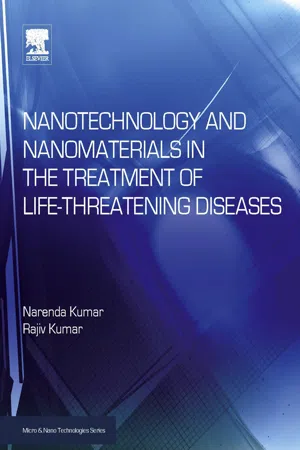Abstract
The chapter on Introduction is designed to introduce the basic concepts of nanoscience/nanotechnology. The general synthetic routes to prepare nanomaterials, particularly useful for medical applications, are described together with their characterization, unique properties arising out of the small size, and potential applications including those for health care. One section of the chapter is devoted to building blocks of human body at molecular and cellular levels in order to develop an understanding about the diagnostic/therapeutic effectiveness of nanomaterials at cellular levels. Other sections, on the other hand, give a brief description about the emerging applications of different types of nanomaterials, in different roles (i.e., drug delivery, therapeutics, imaging contrast agents, etc.), together with toxicity and regulatory issues.
1.1 Nanoscience and nanotechnology
The three big scientific revolutions that happened in the 20th century and are continuously changing over everyday life are information technology, biotechnology, and science of nanomaterial at micro- and nanoscale. As a consequence of such changes, a series of technologies have emerged as ways to improve human wellbeing, particularly in terms of their comfort as well as health care.
Nanoscience is the study of the properties of, and phenomenon in, materials having typical sizes in the range of 1–100 nm. The prefix Nano is a Greek word which means dwarf. Nanometer refers to the length scale of one billionth of a meter (10−9 m). It is the most important development during the last couple of decades. Many definitions have been suggested to define nanotechnology [1]. However, the one suggested by NASA is taken to be more acceptable, i.e. Nanotechnology is the technology that creates functional materials, devices and systems through control of matter on a nanometer length scale (1–100 nm) and exploitation of novel phenomena and properties (physical, chemical, and biological) at nanometer scale or said in a simple way, at atomic and molecular level. Figure 1.1 gives an idea about the size and shape of materials at atomic, molecular, nano-, micro-, and macro scale together with existing building blocks of life and synthetic structures falling in nanometer size [2].
Figure 1.1 Size comparison between man-made and biologically available nanomaterials [2a]. Reproduced with permission from ASPBS.
When matter is divided into such a small dimension as nanometric, its physical, chemical, and biological properties change drastically. Accordingly the relationship between Nanoscience and nanotechnology has been largely symbiotic, with scientific discoveries leading to new technologies that in turn usher in new fundamental insights. This ability to precisely control atoms and build molecules at extremely small length scales holds the promise for important breakthroughs in healthcare, manufacturing, agriculture, energy, information technology, national securities, etc. This is why some are calling it a Nanoscience and nanotechnology revolution.
One of the fascinating features of nanotechnology is that on the nanometer scale all the natural sciences meet and intertwine. Physics meets life sciences as well as chemistry, engineering, materials sciences, and computational approaches, which communicate together and are closely linked. This inherent interdisciplinary feature, not seen in any other science and technology discipline, poses a challenge and offers enormous potential for fruitful cross-fertilizations in a specific area. Undoubtedly, the growth in this area has been tremendous and unprecedented for contribution of a number of factors. Important among them are unique and novel physical, chemical, and biological properties with application in diverse fields together with the availability of a variety of new tools such as scanning probe microscopy, spectroscopy, etc. That we can see, measure, and manipulate materials in the nanometric scale regime below.
1.1.1 Historical
It is rather difficult to fix a date for the discovery of Nanoscience, as the existence of nanomaterials and nanotechnology in both living and nonliving things can be traced back to when science began. For instance, cells in animals and plants are the glaring examples of the multifunctional nano-machine together with naturally occurring or man-made colloidal particles which fall very much in line with nanomaterials.
In ancient times, nanoparticles were used by the Damascans to create swords with exceptionally sharp edges and by Romans to craft iridescent glassware. For example, the Lycurgus Cups, Figure 1.2, known since AD 400 are made of a glass that changes color when light is shown upon them. These contain silver-gold alloyed nanoparticles distributed in such a way so as to look green in reflected light and brilliant-red in transmitted light. Which type of light is passed through these historic structures is the result of hundreds of years of trial-and-error experimentation by craftsmen passing their skills and know-how down through generations. Without realizing that what they have achieved is known now as nanotechnology is an emerging discipline of science and technology. Modern nanotechnologists can however learn from the wisdom of those forgotten antics.
Figure 1.2 The Lycurgus Cup made from glass appears red in transmitted light and green in reflected light. The glass contains 70 nm particles as seen in the transmission electron micrograph. The cup itself is dated to 4th century AD, but the metallic holder is a later addition [2b]. © Trustees of the British Museum.
The idea of atom-by-atom construction was first put forth in a scientific manner by the Nobel Prize winning physicist Richard Feynman in 1959 [3] in his famous lecture called “There is Plenty of Room at the Bottom.” In his speech he predicted that an entire encyclopedia would one day fit on the head of a pin and a library with all the world books would fit in three square yards. He also predicted that microscopic computers, atomic rearrangements, and Nanomedicines could float in veins.
Unfortunately, scientists and engineers did not take too much notice of these predictions at that time. Though a few years later in 1963, Sandomirskii theoretical predication [4] showed that the band gap energy of semiconductors can vary with thickness and there were experimental verifications by Stasenko [5] in 1968, called quantum size effect in a related event of nanotechnology. As a matter of fact, the term “Nanotechnology” was first used and defined in 1974 by Norio Taniguchi of the Tokyo Science University in Japan. According to his definition “Nanotechnology mainly consists of processing, separation, consolidation, and deformation of materials by one atom or one molecule.” Ekimov’s [6] reported the finding of three-dimensional quantum confinements of nanoparticles in 1981 however, the actual publication of a book entitled “Engine of creation” by Eric Drexler in 1986 [7] is considered to be the beginning of the present-day nanotechnology revolution. This book indeed became very popular and excelled in the treatment of the promises and potential of nanotechnology. Drexler envisioned a molecular nanotechnology discipline that would allow manufacturers to fabricate products from the bottom-up with increased molecular control. This technology would allow every molecule to be inserted into its specific place, so that the manufacturing systems using this process would be clean, efficient, and highly productive. The brief showed higher throughputs than modern manufacturing techniques that use macroscopic manipulators to fabricate devices. Around the same time the development of scanning probe microscopy by IBM Scientists allowed them fulfill Feynman’s vision of atom-by-atom construction of molecules.
Furthermore, the discovery of Fullerene by Smalley in 1986 [8] and carbon nanotubes by Iijima [9] in 1991, both allotropes of carbon in nanosize form, were other cornerstones to give a boost to the research on nanotechnology.
1.1.2 Synthesis of nanoparticles [10]
Several hundreds of nanomaterials belonging to maybe inorganic, organic, or polymeric or composite categories have now been obtained by the following general approaches, i.e.
(a) A top-down approach.
(b) A bottom-up approach.
The main objectives for applying a particular technique were as follows: (I) the synthetic method should be reproducible, (II) the method should produce monodispersed nanoparticles, (III) the surface of the nanoparticle should be defect free, and (IV) the method should be economical, scalable, and environment friendly.
1.1.2.1 Top-down methods
The top-down approach involves the breaking down of the bulk material into nanosized structure and particle. These approaches are inherently an extension of those that have been used for producing micron-sized products. They involve the slicing or successive cutting of a bulk material to get nanosized particles or to produce their desired struct...


